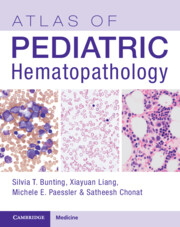Book contents
- Atlas of Pediatric Hematopathology
- Atlas of Pediatric Hematopathology
- Copyright page
- Contents
- Contributors
- Section I Peripheral Blood
- Section II Normal and Non-neoplastic Hematolymphoid Diseases
- Section III Mature Lymphoid Neoplasm
- Chapter 8 Mature B-Cell Non-Hodgkin Lymphoma
- Chapter 9 Mature T-Cell and NK-Cell Non-Hodgkin Lymphomas
- Chapter 10 Hodgkin Lymphoma
- Chapter 11 Posttransplant Lymphoproliferative Disorder
- Chapter 12 Immunodeficiency-Associated Lymphoproliferative Disorders
- Section IV Precursor Hematopoietic Neoplasms and Related Neoplasms
- Section V Histiocytic Neoplasm and Miscellaneous Bone Marrow Diseases
- Index
- References
Chapter 10 - Hodgkin Lymphoma
from Section III - Mature Lymphoid Neoplasm
Published online by Cambridge University Press: 25 November 2023
- Atlas of Pediatric Hematopathology
- Atlas of Pediatric Hematopathology
- Copyright page
- Contents
- Contributors
- Section I Peripheral Blood
- Section II Normal and Non-neoplastic Hematolymphoid Diseases
- Section III Mature Lymphoid Neoplasm
- Chapter 8 Mature B-Cell Non-Hodgkin Lymphoma
- Chapter 9 Mature T-Cell and NK-Cell Non-Hodgkin Lymphomas
- Chapter 10 Hodgkin Lymphoma
- Chapter 11 Posttransplant Lymphoproliferative Disorder
- Chapter 12 Immunodeficiency-Associated Lymphoproliferative Disorders
- Section IV Precursor Hematopoietic Neoplasms and Related Neoplasms
- Section V Histiocytic Neoplasm and Miscellaneous Bone Marrow Diseases
- Index
- References
Summary
Hodgkin lymphomas (HLs) encompass two morphologically, immunophenotypically, and clinically distinct subtypes of B-lineage lymphoma – classical Hodgkin lymphoma (cHL) and nodular lymphocyte predominant Hodgkin lymphoma (NLPHL) [1–5]. HLs usually affect lymph nodes. These lymphomas are composed of a small number of large dysplastic mononuclear and multinucleated neoplastic cells (Hodgkin, Reed-Sternberg [RS], and lymphocytic and histiocytic [L&H] cells) set in the background of benign inflammatory elements with or without abundant band-like and/or more diffuse collagen fibrosis [1].
- Type
- Chapter
- Information
- Atlas of Pediatric Hematopathology , pp. 90 - 97Publisher: Cambridge University PressPrint publication year: 2023



